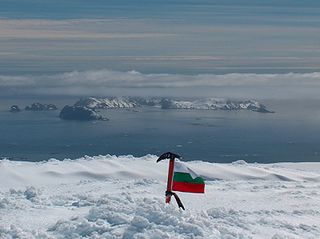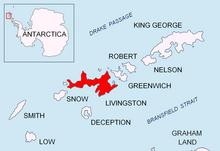
Kotis Point is a point on the northwest coast of Varna Peninsula on Livingston Island in the South Shetland Islands, Antarctica forming the south side of the entrance to Eliseyna Cove. The point is featuring a conspicuous rock at its tip, situated 3 km northeast of Bezmer Point, 6.6 km southwest of Williams Point and 12.6 km east-northeast of Siddins Point. It was named after the Thracian King Kotis I, 384-359 BC.

Pomorie Point is a point on the coast of McFarlane Strait forming the north side of the entrance to Lister Cove, Varna Peninsula, Livingston Island in the South Shetland Islands, Antarctica.

Rongel Reef, is a moraine reef in the Emona Anchorage in the eastern parts of Livingston Island in the South Shetland Islands, Antarctica. The reef emerged during a glacier retreat in the late 20th and early 21st centuries.

Avitohol Point is a point on the north coast of Livingston Island, Antarctica projecting 1.15 km (0.71 mi) into Hero Bay to form the west side of the entrance to Skravena Cove and the southeast side of the entrance to Prisoe Cove. It is surmounted by Fletcher Nunatak and Belev Nunatak. The point is named after the legendary Khan Avitohol listed in the 8th Century Nominalia of the Bulgarian Khans, who laid the foundations of the Bulgarian statehood in Europe in 165 AD.

Desolation Island is one of the minor islands in the South Shetlands archipelago, Antarctica situated at the entrance to Hero Bay, Livingston Island. The island is V-shaped with its northern coast indented by Kozma Cove. Surface area is 3.12 square kilometres (1.20 sq mi).

Ficheto Point is an ice-free point on the northeast coast of Varna Peninsula, Livingston Island, Antarctica forming the southeast side of the entrance to Dragon Cove. Channel Rock is lying in the adjacent northwestern part of McFarlane Strait, 1.3 km (0.81 mi) northeast of Ficheto Point and 920 m (1,010 yd) south-southwest of Meade Islands. The area was visited by 19th century sealers.

Ballester Point is a point forming the south side of the entrance to Johnsons Dock and the northeast side of the entrance to Española Cove in Hurd Peninsula, Livingston Island in the South Shetland Islands, Antarctica. The area was visited by early 19th century sealers operating from Johnsons Dock.

Lukovit Point is an ice-free point on the coast of Hero Bay, Livingston Island in the South Shetland Islands, Antarctica forming the west side of the entrance to Maleshevo Cove. Situated 2.74 km west-southwest of Siddins Point, 3.27 km east by north of Atanasova Point and 5.6 km east of Kuklen Point. Shape enhanced as a result of the retreat of Tundzha Glacier in the late 20th and early 21st centuries. Spanish mapping in 1991, Bulgarian in 2005 and 2009. Named after the town of Lukovit in northern Bulgaria.

Elephant Point is a small predominantly ice-free promontory projecting 2 km into Bransfield Strait at the south extremity of the west half of Livingston Island in the South Shetland Islands, Antarctica. The point forms the southwest side of the entrance to Kavarna Cove, and is surmounted by Rotch Dome on the north. Ice-free surface area 109 hectares. Dryad Lake is situated on the west side of the point. The area was visited by early 19th century sealers.

Spark Point, also Canto Point, is a rocky point forming the northwest side of the entrance to both Discovery Bay and Galápagos Cove, and the east side of the entrance to Jambelí Cove in the northeast of Greenwich Island in the South Shetland Islands, Antarctica. The point ends up in a conspicuous monolithic formation and has an adjacent ice-free area of 164 hectares. The area was visited by early 19th century sealers.

Polish Bluff is a point forming the southwest side of the entrance to Española Cove and the northeast side of the entrance to Argentina Cove in Hurd Peninsula, Livingston Island in the South Shetland Islands, Antarctica. The area was visited by early 19th century sealers operating from nearby Johnsons Dock.

Henry Bluff is a point forming the southwest side of the entrance to Argentina Cove and the north side of the entrance to Las Palmas Cove in Hurd Peninsula, Livingston Island in the South Shetland Islands, Antarctica. The point is dominated by a prominent monolithic formation rising to 163 m and named El Peñón by personnel of the nearby Spanish Antarctic Base. The area was visited by early 19th century sealers operating from nearby Johnsons Dock.

Salisbury Bluff is the point forming the south side of the entrance to Las Palmas Cove in Hurd Peninsula, Livingston Island in the South Shetland Islands, Antarctica and surmounted by a 161 m height. The area was visited by early 19th century sealers operating from nearby Johnsons Dock.

Scesa Point is a rounded, low ice-free tipped point on the west coast of Ioannes Paulus II Peninsula, western Livingston Island in the South Shetland Islands, Antarctica forming the north side of the entrance to Zornitsa Cove.

Ferrer Point is a point projecting 700 m into the south part of Discovery Bay, Greenwich Island in the South Shetland Islands, Antarctica with an adjacent ice-free area of 24 hectares. The point forms the west side of the entrance to Montecinos Cove and the northeast side of the entrance to Rodríguez Cove.

Labbé Point is a point projecting 600 m (660 yd) into the southwest part of Discovery Bay from Parvomay Neck, Greenwich Island in the South Shetland Islands, Antarctica with an adjacent ice-free area of 11 hectares. The point forms the northwest side of the entrance to Basullo Cove and the east side of the entrance to Vinett Cove. The small Basso Island is linked by a mainly submerged spit to the north side of Labbé Point.

Organpipe Point is a prominent east–west trending headland rising to about 60 or 70 m on the northwest coast of Varna Peninsula, Livingston Island in the South Shetland Islands, Antarctica and forming the north side of the entrance to Charybdis Cove and the southwest side of the entrance to Griffin Cove.

Gargoyle Bastion is a rocky headland rising to 60 m on the northwest coast of Varna Peninsula, Livingston Island in the South Shetland Islands, Antarctica and forming the south side of the entrance to Hydra Cove and the northeast side of the entrance to Griffin Cove. It has sub-vertical cliff faces to seaward, and is flanked to north and south by rock cliffs.

Yasen Point is the sharp, rocky point on the south coast of Livingston Island in the South Shetland Islands, Antarctica, forming the west side of the entrance to Mateev Cove. Situated on the east side of the small ice-free promontory ending in Hannah Point to the west.

Mihaylovski Cove is the 5 km wide cove indenting for 1.3 km the northwest coast of South Bay in Livingston Island, Antarctica that is entered west of Ereby Point and east of Lukovo Point, and has its head fed by Kamchiya Glacier. The area was known to early 19th century sealers who operated from nearby Johnsons Dock. The feature is named after the brothers Petar Mihaylovski, physician at St. Kliment Ohridski base during the 2007/08 and subsequent seasons, and Hristo Mihaylovski, engineer in the national Antarctic campaign during 2015/16 and subsequent seasons.









